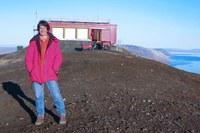Kimberly Strong , a physicist who studies the Earth’s atmosphere, will lead the University of Toronto’s new School of the Environment starting July 1, 2013.
Strong’s research in atmospheric measurements examines such key environmental issues as climate change and its relationship to contributing factors including stratospheric ozone depletion and tropospheric pollution. She has directed ground-based, balloon-borne and satellite projects to study the Earth’s atmosphere, particularly in the Arctic.
“We are thrilled to have Kim Strong serve as director of the School of the Environment,” said Meric Gertler , dean of the Faculty of Arts & Science. “Kim has an extraordinary record as a researcher and has an enviable track record in encouraging and supporting the next generation of environmental scholars and scientists.
"Under her leadership, the school will be known for interdisciplinary research and teaching in environment that spans the sciences, social sciences and humanities.”
The School of the Environment was established in July 2012 to leverage the enormous breadth and depth of environmental teaching and research expertise within the Faculty of Arts & Science.The school offers an undergraduate B.A. program in environmental studies and a B.Sc. program in environment and science, with other new programs in development. It also partners with other departments and programs at U of T to offer a range of collaborative undergraduate specialists, majors and minors, involving chemistry, geography, earth sciences, human biology, physics, philosophy and others.
At the graduate level, interdisciplinary collaborative programs in Environmental Studies, as well as in Environment and Health, are offered in partnership with 20 other units at the university. In addition, distance education and certificate programs provide opportunities for professional development.
“I envision the school as a dynamic unit that serves as a nexus for faculty, bringing together scholars from a wide range of disciplines, strengthening existing links, and creating new ways of collaborating and interacting with colleagues,” said Strong. “It will also serve as a magnet for students interested in the environment, offering them the best courses and programs in this field available anywhere.
"Thirdly, the school will be a portal for the wider community beyond the university, providing access to all of the diverse and interdisciplinary environmental scholarship that is underway here. My job is to make all three happen!”
Strong is one of the founding members of the Canadian Network for the Detection of Atmospheric Change, a group of researchers working to improve atmospheric remote sounding in Canada. In 2004, the group obtained funding from the Canada Foundation for Innovation to equip the Polar Environment Atmospheric Research Laboratory at Eureka, Nunavut to provide a long-term data set for studying the evolution of the Arctic atmosphere and its year-to-year variability. From 1998 to 2006, Strong was principal investigator of the Middle Atmosphere Nitrogen Trend Assessment project, a large collaboration that used high-altitude instrument-carrying balloons to measure trace gases and investigate the changing chemical balance in the mid-latitude stratosphere.
Strong is currently director of the Natural Sciences and Engineering Research Council’s Collaborative Research and Training Experience Training Program in Arctic Atmospheric Science. The program enhances the educational opportunities available to students and postdoctoral fellows interested in polar, atmospheric, and climate sciences, including the use of state-of-the-art instrumentation and analysis of large data sets. She also runs U of T’s Atmospheric Observatory, is principal investigator of the new Canadian Fourier Transform InfraRed Observing Network, and is actively involved in several projects related to better understanding of the atmospheres of Mars and Venus.
Strong and members of her group are actively involved in outreach activities, through an education and outreach program developed by U of T physicist Kaley Walker. This began with a visit to Qarmartalik School in Resolute Bay, Nunavut in 2004, and has since expanded to schools in Hall Beach, Igloolik, Grise Fiord, Iqaluit, and Pond Inlet, as well as many public talks and visits to schools in Southern Canada. Activities ranging from the ambitious “Northern Experience Program” undertaken as part of International Polar Year, to the current “Student-Researchers Atmospheric Collaboration” has brought schools, students, and researchers together in creative ways to enhance their learning experience, excite them about science, and raise awareness of Arctic issues.
Walker and Strong, with the help of two outreach facilitators, graduate students, and post-docs, have developed presentations and hands-on activities appropriate for Kindergarten to grades 12, on topics such as air pollution, ozone depletion, climate, Canadian satellites, space science, and weather. These activities have led to invitations to present hands-on workshops at schools and at teachers’ conferences in Nunavut and Ontario.
A member of U of T’s Centre for Global Change Science, Strong was a visiting fellow at the Centre for Atmospheric Chemistry, University of Wollongong, Australia in 2010. Her awards include the Premier’s Research Excellence Award (2004) and an NSERC Discovery Accelerator Supplement award for three years (2011).
Source: Kim Luke, UofT News
More news about Kim Strong here

